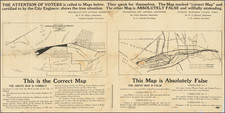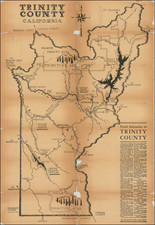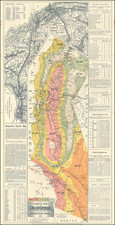With Multiple Game Refuges and Public Camping Sites Shown
Detailed map of the San Bernardino National Forest, published in 1931.
The map shows the region from the High Desert / Victorville area to Temecula and the Cleveland National Forest.
A comprehensive legend accompanies the map, with various symbols denoting key landmarks and features. These include Ranger Stations, triangulation stations used for surveying, lookout and triangulation stations, railroads, primary and secondary roads, first and second class trails, mines, springs, falls, dams, and the forest supervisor's headquarters. Such details not only added to the map's utility but also provided a snapshot of the development and use of the land at that time.
The San Bernardino National Forest was established on February 25, 1893. The creation of the San Bernardino National Forest was an outcome of the broader forest conservation movement in the United States in the late 19th and early 20th centuries. John Muir and President Theodore Roosevelt were among the most influential figures nationally. Locally, individuals like Will Thrall, an advocate for the protection of the San Gabriel and San Bernardino Mountains, played roles in its conservation.
San Bernardino National Forest encompasses parts of the San Bernardino Mountains and San Jacinto Mountains in Southern California. The initial efforts to protect these lands were driven by concerns over watershed protection, deforestation, and unregulated hunting.
The Cleveland National Forest was established on July 1, 1908. The Cleveland National Forest is located in Southern California and spans the counties of San Diego, Riverside, and Orange. It was the first national forest in California. Originally, it was named the Trabuco Cañon Forest Reserve, and later, its name changed to honor former President Grover Cleveland. The impetus for its protection also arose from concerns over watersheds, unregulated logging, and the need for regulated use of forest resources. Over time, the forest has become a vital spot for recreation, including hiking, camping, and bird-watching, among other activities.
The State Game Refuges shown on the map represent a significant milestone in the conservation movement. The concept was rooted in a philosophy that favored not just the preservation of timber and water resources, but also wildlife. Beginning with Lake Merritt in 1869, California began realizing the importance of creating areas where hunting was prohibited or heavily regulated.
Forestry Maps
The following is drawn from the excellent essay The Mapping of Our National Forests by Peter Stark, a Grey Tower Scholar-in-Residence in the Winter of 2014. The full essay can be found here: https://forestservicemuseum.org/wp-content/uploads/2019/11/Mapping-the-National-Forests-Nov19.pdf
Forest Reserve maps were first issued by the General Land Office in the 1890s and early 1900s and were typically small in scale and without significant detail. Generally, these were not distributed to libraries or the public. Following the May 1, 1897 report of the National Academy of Sciences Commission, the US Geological Survey was charged with surveying forests with an eye towards discovering which lands should be eliminated and which lands should be included in the nation’s forest reserves. The Commission thought that the U.S. Geological Survey was the only federal bureau at the time capable of performing such surveys and that the agency should be appointed with an adequate budget to map and inventory the forest reserves.
On July 18, 1898, the Director of the U.S. Geological Survey, Charles D. Walcott, officially transmitted for publication as Part 5 of the Survey’s Nineteenth Annual Report, 1897 – ’98, a 400-page volume on “Forest Reserves” with 110 maps and a large number of photographs. For the next two years, the U.S. Geological Survey’s substantial Annual Report included a Part 5 devoted to an examination of the Forest Reserves.
In 1905, the work of examining forest reserves, etc., together with the men employed upon it, was transferred to the Bureau of Forestry of the Department of Agriculture. The Department of Agriculture would focus most of its efforts on creation of a national Forest Atlas, released in folios. However, it also quickly adopted a decentralized approach to production of maps, relying upon the local forestry offices to create maps which made sense for their regions. The principal of a decentralized administration was championed by Henry S. Graves when he was appointed Forester in 1910. However, when Graves assumed his post as Forester, most mapping was still done in Washington, DC. While some drafting and map work was conducted in the district offices, and a small amount necessarily on the Forests, most work was still done in Washington, DC.
Methods of mapping were outlined in such early publications as the Use Book and National Forest Manual and Instructions for making Forest Surveys and Maps first published in 1907, with a second edition released in 1910. The first edition served as a manual of surveying and map-making in the field. The edition of 1910 added a chapter on preparing sheets for the Forest Atlas. An enlarged third edition appeared in 1912 with a supplement, Signs, Symbols, and Colors, prepared by the Office of Geography.
Forest Service mapping from the period 1910 to 1922 varied greatly from district to district. By 1910 with most forest atlases now complete and with responsibilities for their maintenance placed at the district level, it became necessary for each district to recruit and hire cartographers and draftsmen capable of making and revising maps as well as making township and control surveys in the field. Each Forest Service District could determine its mapping priorities, but Washington enforced map standards and arranged for engraving and printing services. After 1916, District cartographers were more often cited on Forest Service maps as the entity that compiled the maps while the Washington office continued to arrange for drafting and printing work. The Forest Service did not have its own printing plant and relied during this period almost exclusively on the engraving and printing services of the U.S. Geological Survey for its map production and, to a lesser extent, on the services of the Government Printing Office, both in Washington, D.C.
Beginning in 1914, the first 7 "Forest Visitor Maps" were produced, following by 11 in 1915, 24 in 1916, 15 in 1917, and 4 in 1918.
After 1918 and until about 1924 the uniformity of forest visitor maps ended as national forest districts produced a wide variety of non-standard maps and publications for their users with more printing done by the Government Printing Office. District 5 created a series of small-scale road maps for the national forests of California similar in size and format to the “in and out” maps that the Southern California Automobile Club published at the time for western cities. This series used the common title of “Automobile Route Map of the…. National Forest or Forests” as the case may be, on the map’s title panel. The maps represented a significant departure from the large-scale folded forest visitor maps published between 1914 and 1918. Districts 3, 4, and 7 each issued recreation maps covering their districts as a whole, as in the 1922 map, National Forests, District 3, Showing Main Highways, or a large portion of their territory, such as District 4’s Recreation map of the National Forests of South Central Idaho also issued in 1922. In 1919, District 2 issued nine forest visitor booklets for its national forests complete with text, photographs, and a sketch map folded and inserted at the back of the booklet, all printed by the Government Printing Office. District 6 also produced a number of booklets with maps for the forest visitor folded inside the back cover. These were included in the Department of Agriculture’s Departmental Circular series as “Contribution from the Forest Service.” Finally, the Northern District produced a series of four, 1:500,000-scale “Quadrangle” maps for the public covering the heart of the northern Rocky Mountains between 1922 and 1924.











![Parts of E. California and S. E. Nevada, N.W. Arizona and S.W. Utah __ Atlas Sheet No. 66 [Shows Las Vegas!]](https://storage.googleapis.com/raremaps/img/small/92030.jpg)
![[ Alaska / Cabo San Lucas / San Blas / Chile ] Views of Headlands and Islands on the Coasts of North West and South America](https://storage.googleapis.com/raremaps/img/small/88077.jpg)

![Lands of the Hemet Land Co. [Hemet Southern California. Its homes and scenes]](https://storage.googleapis.com/raremaps/img/small/89106.jpg)